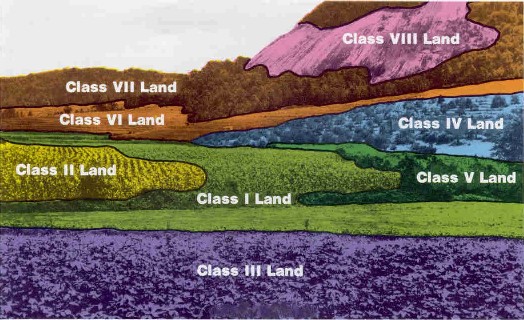
RI Capability classes and subclasses
More Information: http://soils.usda.gov/technical/handbook/contents/part622p2.html#cap_cls

Capability classes and subclasses show, in a general way, the suitability of soils for most kinds of field crops. The soils are classed according to their limitations when they are used for field crops, the risk of damage when they are used, and the way they respond to treatment. The grouping does not take into account major and generally expensive landforming that would change slope, depth, or other characteristics of the soils; does not take into consideration possible but unlikely major reclamation projects; and does not apply to rice, cranberries, horticultural crops, or other crops that require special management. Capability classification is not a substitute for interpretations designed to show suitability and limitations-of groups of soils for rangeland, for forest trees, or for engineering purposes.
In the capability system, all kinds of soil are grouped at three levels: capability class, subclass, and unit (5). The capability classes and subclasses are defined in the following paragraphs. A survey area may not have soils of all classes. Capability units are not used in this survey area.
Capability classes, the broadest groups, are designated by Roman numerals I through VIII (NOTE: On the digital join table Arabic numerals are used – 1 through 8). The numerals indicate progressively greater limitations and narrower choices for practical use. The classes are defined as follows:
Class I soils have few limitations that restrict their use.
Class II soils have moderate limitations that reduce the choice of plants or that require moderate conservation practices.
Class III soils have severe limitations that reduce the choice of plants, or that require special conservation practices, or both.
Class IV soils have very severe limitations that reduce the choice of plants, or that require very careful management, or both.
Class V soils are not likely to erode but have other limitations, impractical to remove, that limit their use.
Class VI soils have severe limitations that make them generally unsuitable for cultivation.
Class VII soils have very severe limitations that make them unsuitable for cultivation.
Class VIII soils and landforms have limitations that nearly preclude their use for commercial crop production.
Capability subclasses are soil groups within one class; they are designated by adding a small letter, e, w, s, or c, to the class numeral, for example, IIe. The letter e shows that the main limitation is risk of erosion unless close-growing plant cover is maintained; w shows that water in or on the soil interferes with plant growth or cultivation (in some soils the wetness can be partly corrected by artificial drainage); s shows that the soil is limited mainly because it is shallow, droughty, or stony; and c, used in only some parts of the United States, shows that the chief limitation is climate that is too cold or too dry.
In class I there are no subclasses because the soils of this class have few limitations (NOTE: The digital data has subclasses added to class I soils due to database constraints, please ignore the subclass on class I soils). Class V contains only the subclasses indicated by w, s, or c because the soils in class V are subject to little or no erosion, though they have other limitations that restrict their use to pasture, rangeland, woodland, wildlife habitat, or recreation.
Dual Classes: On the digital soil data some Capability classes and subclasses have dual ratings separated by a / for example 7s/8. This is used for soil complex map units where the two soils in the complex have different classes. In map unit complexes where both soils have the same capability class the / is not used.
Back to Rhode
Island Soil Survey
Back to Nesoil.com